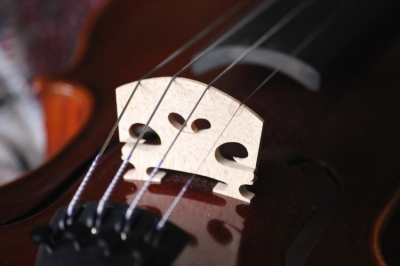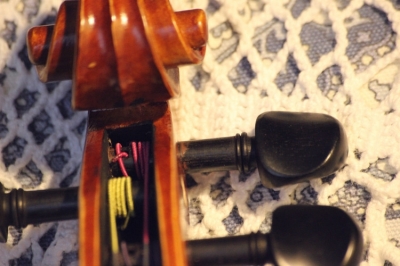Welcome to our forum. A Message To Our New and Prospective Members . Check out our Forum Rules. Lets keep this forum an enjoyable place to visit.
 Topic RSS
Topic RSS



 (2 votes)
(2 votes) Regulars
 Offline
Offline





Regulars







Regulars
 Offline
Offline


@Gordon Shumway, I think you mentioned that you strung up some Pirastro Tonicas about a week ago. You might just need to give that A-string a couple of more days and then it will settle down, especially if the prob is that it's still detuning or too metallic (fresh aluminum winding?)
When I first put on my Pirastro Obligatos, it took a while for that metallic, raspy sound to wear off.
Well, there's also always the chance that the aluminum wound Tonica A-string is just too bright or projecting to make your instrument and your ears happy. Fortunately, trying a different A-string
Regulars
 Offline
Offline





I've got Tonicas on the wood violin and original cheap steels on the electric violin.
But now that you mention it, maybe I was playing the EV too much and forgetting to compare it with the wood.
No, they're kind of similar - I find the A strings sound scratchier, and it's much worse near the frog (that's probably all about weight, but the question is why the A string is more sensitive to it), and I think I'm always bowing too close to the fingerboard. It's partly cos I've got a huge mute on it and I can't see over it, and partly because I don't want to play loud near the bridge. Under these conditions, the A strings seem hardest to handle. Even if the bow is at fault, it doesn't answer the question.
I need to start bowing exactly midway between bridge and fingerboard.
Andrew
Verified human - the ignominy!
Regulars
 Offline
Offline





bocaholly said
When I first put on my Pirastro Obligatos, it took a while for that metallic, raspy sound to wear off.Well, there's also always the chance that the aluminum wound Tonica A-string is just too bright or projecting to make your instrument and your ears happy.
It seems to be the combination of bow speed and pressure - on the A string I seem to be applying more pressure than the bow speed requires, whereas the G and D (and the E, I think) are perfectly happy with that same combination of bow speed and pressure.
That doesn't mean the combination is right for the G and D strings - it may just mean they are more tolerant.
Andrew
Verified human - the ignominy!
Regulars
 Offline
Offline


Member
 Offline
OfflineI have question about the A string. I have only played for 6 months, teaching myself. The thing is when I play the A string closer to the bridge the sound sometimes completely cut out. From what I can tell there is nothing or no coating on the string to obstruct. If I play further away from the bridge the bow bounces. What is the reason? What can I do?
Regulars
 Offline
Offline


@Adenium, First off, welcome to the forum!
As Fiddlerman mentioned, above, plenty of violins are tricky on the A string.
Perhaps you can post a photo of your bridge with a good view of it's arch and how the strings sit on the notches. Same for a photo of the nut. I'm just playing sorcerer's apprentice but there is some chance that the way the A string notches are cut is part of your problem.
In the meantime, try loosening the tension on your bow (just tight enough so that you don't bottom out on the stick) That helps me with the bouncing.
Here are a couple of pictures of the specific areas of the Violin. Thank you for taking your time to help. The bouncing of the bow only becomes an issue when I try to move down the A string away from the bridge, because the sound cuts out half way through the stroke. I don't have a problem with the other strings. The violin is new, a Concert Violin bought from the Fiddlershop, otherwise a fine violin. It feels like there is a little resistance on the A string as if there is some coating on it, but I can neither see or feel anything stuck to the string.
Regulars
 Offline
Offline


Hmmmmm... a couple of more sorcerer's apprentice thoughts:
Can you dig up someone with solid violin playing experience to try that A string and see if the problem persists?
Any chance you have a new, spare set of strings on deck and could try switching out that A string?
And a last question. Is the problem the same on all notes in first position, on just one or mostly on the open A string?
Advanced member
@Adenium I already wrote a reply about the chat but I'll reply here too.
When you say the bow bounce, do you really mean that the bow bounces, or just an extra vibrating sound of some sort? The bow bouncing is usually about tension in your arms/hands/body in general. In some cases it could be a bow wound too tight. So if loosening it doesn't help, I suggest spending some time every practice session doing 1-minute bows. It helped me with my awful bouncing. I still get some of it due to tension and exhausted arms from work, but it's a lot better and I can play smooth occasionally.
That it only happen on the A string could have something to do with your body and the angle you have to play the A string. My bounce was always worst on the A string.
Playing near the bridge WILL make you loose sound. The higher up on the fingerboard you play, the closer to the bridge the soundpoint will be. But if you're only in 1st, stay around the middle. Even in 3rd I still have to stay very close to mid to get a sound.
Thank you to everyone for all your helpful tips.
I think part of the bounce problem is just me, I need to practice as you said, get the right feel and posture. When ever the note cut out on the A string it was on either the open string or all the notes on the A string. I will try to apply your advice...when you teach yourself you sometimes get a little unsure of how and what to do but I think I am making progress 
Honorary advisor
Regulars
 Offline
OfflineHonorary advisor
Regulars
 Offline
OfflineI have another question.Pierre talks about crushing notes usually on high on the G string and how the more expensive better made violins mostly don't. What is the cause of the crushing notes? I mean' what is is about the violin that allows the note to be crushed? Is it the tail piece or something completely different?
Regulars
 Offline
Offline




markcobb said
I have another question.Pierre talks about crushing notes usually on high on the G string and how the more expensive better made violins mostly don't. What is the cause of the crushing notes? I mean' what is is about the violin that allows the note to be crushed? Is it the tail piece or something completely different?
It is just an assumption, but I think it has to do with how well the fingerboard is made, since as you go up the neck the notes will be closer and closer together requiring more precision.. So I'm guessing if the fingerboard is not made to specifications and has even the slightest bump next to where you're holding the note down.. it can touch the string and cancel out the vibrations, choking the sound?... I don't know 
1 Guest(s)


 Log In
Log In Register
Register Home
Home






















